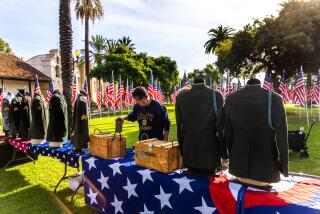V-E Day Plus 40--GIs Return to Patton’s Camp
- Share via
CHIRIACO SUMMIT, Calif. — Veterans of Gen. George S. Patton Jr.’s World War II battles in Africa and across Europe marked the 40th anniversary of V-E Day Wednesday at the desert camp location where they trained for the war against the Nazis.
About 50 veterans were among the 400 people present as a single rock pyramid monument was dedicated to the World War II Desert Training Center, which was located near this tiny town on Interstate 10, 30 miles east of Indio.
Before and after the ceremony, the one-time soldiers swapped tales, showed each other vintage photographs and reminisced.
For seven months in 1942, Patton and his 60,000 tank corpsmen and artillerymen learned to fight and survive in the desert in preparation for battles in North Africa and later in Europe.
Nearly 300,000 soldiers in all were in training from March, 1942, through April, 1944, in 10 camps spread over 18,000 square miles of Southern California and Arizona land making up the Desert Training Center, the world’s largest Army post.
Charles Jeglinski, 74, of Venice and Ralph Delgado, 60, of Ontario showed up wearing their World War II Army uniforms and brought along memorabilia and photos of the tent camps and Patton.
“Here’s one you fellas don’t have,” said Frank Carroll, 65, of Phoenix, who trained here and fought with Patton. “Remember what Patton said he was going to do when he reached the Rhine? Here’s proof he kept his promise.”
Carroll reached into an envelope and produced a picture of Patton urinating in the Rhine River.
Next to the monument and speaker’s stand was a sign that proclaimed: “Future Home of Gen. Patton Museum.”
Gerry Hillier, California desert district manager for the Bureau of Land Management and master of ceremonies at the event, explained that the monument is the first step by the bureau in developing a Patton Memorial Visitor’s Center to house personal papers of the World War II general, artifacts and reminiscences and records of those who trained at the desert center.
Ev Hayes, Needles area manager for the Bureau of Land Management, which administers the center, said the agency received more than 700 letters from men in 40 states after a story about the training center appeared in the Los Angeles Times and other newspapers across the country. The letters will help the bureau piece together the history of what happened here.
Tacked to a display of photographs marked, “Patton’s Camp Revisited,” was a photo showing Patton in his headquarters tent at Camp Young making an announcement over the center’s radio station, SSCY (Special Service Camp Young.)
Compliment Soldiers
Patton’s troops at the dedication said music was played on the radio station and Patton would come on the air unannounced and compliment his soldiers “or give them hell” for something they had done wrong.
“We never knew when the music was going to stop and Patton was gonna start,” one of the veterans said with a laugh.
The invocation was delivered by the Rev. William B. Pettigrew, 64, of the United Methodist Church of Walnut Creek, Calif. Pettigrew was a sergeant in Patton’s European command.
“He was firm, yes. But he was also a warm, tender, caring human being, a great general,” insisted Pettigrew.
Asked if Patton was profane? The minister replied, ‘Well, he did swear some.”
The land for the memorial was donated by Joe Chiriaco, 80, who founded the town of Chiriaco Summit in 1933 and operates a store, cafe, gas station, motel, auto wrecking yard and trailer park here.
Chiriaco recalled the first day Patton came into his store and introduced himself. Chiriaco said Patton told him: “You run your place, and I’ll run the Army. But I’d like to buy 28 acres of your land to build an airstrip.”
Chiriaco sold the Army the 28 acres for $5 an acre.
Dorothy Roark, 68, of San Bernardino told of working for the Metropolitan Water District’s Camino power station and recalled how the troops on maneuvers would often get lost and stop by her office for directions.
Seemed Embarrassed
“One day old Patton himself drove up in a Jeep. He pulled out a map and asked me to show him where he was. I showed him. He seemed a bit embarrassed, thanked me and left.”
Lt. Gen. Robert Arter, commander of the 6th Army, Presidio, San Francisco, gave the keynote address and Edward L. Hastey, California Bureau of Land Management director, presided at the unveiling of the monument, which contains three plaques on the rock pyramid telling the story of the Desert Training Center.
More to Read
Sign up for Essential California
The most important California stories and recommendations in your inbox every morning.
You may occasionally receive promotional content from the Los Angeles Times.













